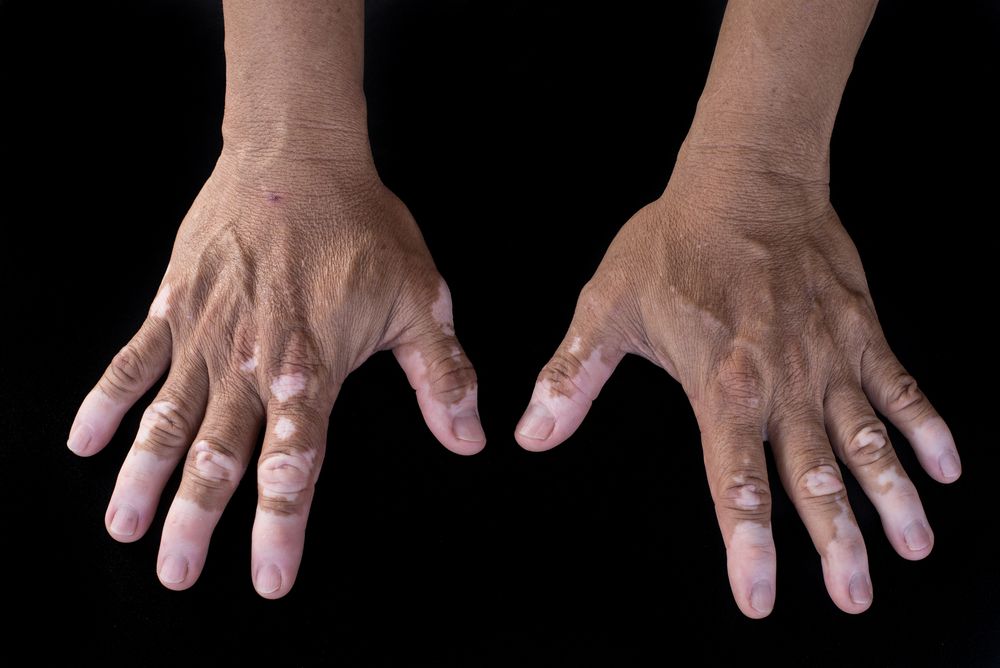- Acne
- Actinic Keratosis
- Aesthetics
- Alopecia
- Atopic Dermatitis
- Buy-and-Bill
- COVID-19
- Case-Based Roundtable
- Chronic Hand Eczema
- Drug Watch
- Eczema
- General Dermatology
- Hidradenitis Suppurativa
- Melasma
- NP and PA
- Pediatric Dermatology
- Pigmentary Disorders
- Practice Management
- Precision Medicine and Biologics
- Prurigo Nodularis
- Psoriasis
- Psoriatic Arthritis
- Rare Disease
- Rosacea
- Skin Cancer
- Vitiligo
- Wound Care
Article
A basic primer on vitiligo
Author(s):
Vitiligo affects 3 million people of all skin types per year in the U.S. In this article, Dr. Wheeland summarizes the latest updates on vitiligo, highligting promising treatments to come.
Vitiligo usually first develops on sun-exposed areas, like the face, lips, hands and arms. (TofacitinibAnon.P/Shutterstock.com)

Dr. Wheeland

Having been born and raised in Arizona, I benefitted from being exposed to multiple ethnicities, religions, cultures and languages starting when I was just a kid. Many of my friends were Hispanic but we were all like a big, happy family. Differences in skin color were just not relevant. My best friend was Jorge (Spanish for “George”), and we played every day at the school playground, nearby parks or at each other’s homes where Jorge’s mother introduced me to my first homemade green chile and bean burrito. It was love at first bite.
Jorge’s mom had a very noticeable discoloration on her face that I couldn’t ignore, but it didn’t seem to bother her - at least to my five year-old eyes, and Jorge had no knowledge or even awareness of his mother’s condition.
“Oh, no,” he told me, “she’s always looked like that,” which ended the discussion so we could get back to the more important task of kickball.
Of course, as I got older, I learned that Jorge’s mom had vitiligo, which is a relatively common disease of unknown cause that affects 3 million people of all skin types per year in the United States. As this month’s issue on disorders of pigmentation, I thought I would use this opportunity to update my knowledge on vitiligo which would perhaps serve as an introduction to this month’s issue.
Since I have only treated a small number of patients with vitiligo and that was a while ago, I had a lot to learn. Here are some of the things that I learned:
The blotchiness of vitiligo is due to the death of melanocytes. The disease proceeds unpredictably as far as extent and rate of progression are concerned. It can last a life time or persist for just a few years. It can begin at any age, but often before 20 years of age. It may be familial or may develop following some stressful event or even a severe sunburn. It may also represent an autoimmune disease.
Vitiligo usually first develops on sun-exposed areas, like the face, lips, hands and arms. It may also affect the retina. It may appear in a segmental distribution, remain localized or become generalized. There is no known cure.
It should be obvious that the loss of pigmentation can be life altering and may cause significant psychological problems like depression, depending on the extent or areas of involvement. With the loss of pigmentation due to melanocyte death or cessation of function, patients may be susceptible to sun burns and iritis may also develop.
Treatment may be successful if application of steroid creams is started early. Similarly, application of calcineurin inhibitor ointments (tacrolimus or pimecrolimus) may provide some improvement. Cautious use of UVB or careful application of photochemotheray using topical or oral psoralen coupled with UVA or light from an excimer laser two to three times a week for six months has proven helpful in some cases. However, only rarely does the skin color return to normal. Tattooing can be performed on small areas of involvement, but the color around the tattooed site is difficult to match and seasonal fluctuation in color due to sun exposure can be expected. For small areas of involvement, transplantation of melanocytes contained in suction blisters from areas of uninvolved skin that can be hidden by clothing may be useful, but irregularity in the skin color may persist.
The greatest number of published articles dealing with the treatment of vitiligo have focused on producing irreversible depigmentation using a variety of chemicals. However, this approach is usually not recommended unless the involvement is greater than 50-60%.
The most common medicines used for this purpose are monobenzyl ether of hydroquinone (MBEH) or monoethyl ether of hydroquinone (MMEH). Topical application of 88% phenol to small areas only has been reported to provide some degree of depigmentation, but potential harm to internal organs is possible if larger areas are treated. There are some reports of a drug used for the treatment of chronic myeloid leukemia (imatinib) having an unexpected complication of depigmentation suggesting that more research is needed to determine its potential usefulness in treating vitiligo.
Use of protein kinease inhibitors, prostaglandin E-2, tofacitin IB, EGFR inhibitors and afamelanotide injected under stable lesions to induce repigmentation all provide hope that a successful treatment for vitiligo may be developed in the near future.
There are also some uncontrolled reports of herbs like gingko biloba, protea madiensis and myrica ruba being useful in treating vitiligo, but further research is required before they can be recommended.
Lastly, there is hope that the development of immunotherapy for treating melanoma may prove useful for treating vitiligo as well.
My conclusion from updating my knowledge of vitiligo is that while its cause remains mysterious and treatment has shown only slow progress, there is enough to hope that people like my childhood friend’s mother won’t have to live with
this disfiguring disease forever.
Newsletter
Like what you’re reading? Subscribe to Dermatology Times for weekly updates on therapies, innovations, and real-world practice tips.










